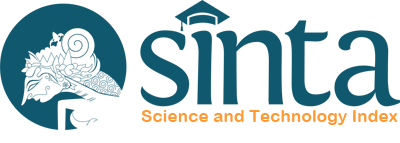FOTODEGRADASI ZAT WARNA METHYLENE BLUE DENGAN SINAR UV DAN FOTOKATALIS NANOPARTIKEL PERAK
Abstrak
The textile industry is one of the producers of liquid waste that contains many synthetic dyes and difficult to decompose such as methylene blue (MB). Approximately 15-20% of the MB products that cannot be reused will go into the wastewater which eventually be drained into the catchment waters. This causes a variety of negative impacts, especially in the water environment. One way to prevent this problem is by decomposing the dye using UV light and accelerating the decomposition process with the photocatalysts, namely silver nanoparticles. The purpose of this study is to determine the optimal conditions for the photodegradation process of MB dyes, and the effectiveness of the degradation of MB dye under optimal conditions. The search was conducted by firstly finding the optimal conditions of the photocatalyst / NPAg volume, irradiation time, and pH. The optimal condition was then applied to photodegrade various concentrations of MB to determine the effectiveness of the process. The results showed the optimal condition of MB photodegradation was 10 mL of photocatalyst / NPAg, 60 minute irradiation time at pH 4. Under such condition, the method effectively degraded 98.21% of100 ppm MB. The method used is also effective for MB up to 150 ppm because it is able to degrade almost 100%.
Keywords: photocatalyst, photodegradation, NPAg, methylene blue, plumeria rubra.
##plugins.generic.usageStats.downloads##
Referensi
Bakir. 2011. Pengembangan Biosintesis Nanopartikel Perak Menggunakan Air Rebusan Daun Bisbul (Diospyros Blancoi) Untuk Deteksi Ion Tembaga (II) dengan Metode Kolorimetri. Skripsi. FMIPA UI. Jakarta.
Chatterjee, D., Patnama, V., Sikdar, A., Joshi, P., Misra, R., Rao, N. 2008. Kinetics of The Decoloration of Reactive Dyes Over Visible Light Irradiated TiO2 Semiconductor Photocatalyst. Journal of Hazardous Materials. 156: 435–441.
Dae-Hee A., Won-Seok C., & Tai-Il Y. 1999. Dyestuff Wastewater Treatment Using Chemical Oxidation, Physical Adsorption and Fixed Bed Biofilm Process, Process Biochemistry. 34: 429–439.
Elemike, E.E., Onwudiwe, D.C., Ekennia, A.C., Ehiri, R.C., Nnaji, N.J. 2017. Phytosynthesis of silver nanoparticles using aqueous leaf extracts of Lippia citriodora: Antimicrobial, larvicidal and photocatalytic evaluations. Materials Science and Engineering. 75: 980-989.
Haryono, A., Dewi, S., Harmami, S. B., dan Randy, M. 2008. Sintesa Nanopartikel Perak dan Potensi Aplikasinya. Jurnal Riset Industri. 2 (3): 156-163.
Hermann, J.M. 1999. Water Treatment by Heterogeneous Photocatalys, In F.A. Jassen. Environmental Catalysis. Singapore: Imperial College Press.
Kepmen LH No. KEP-51/MENLH/10/1995. Tanggal 23 Oktober 1995. Tentang Baku Mutu Limbah Cair Bagi Kegiatan Industri.
Khosi'atun. 2016. Biosintesis Nanpartikel Perak dengan Reduktor Ekstrak Kulit Pisang Kepok (Musa paradisiaca Linn.) dan Laju Pembentukannya. Skripsi Teknik Kimia. Universitas Negeri Semarang, Semarang.
Kumar, V., & Yadav, S. K. 2009. Plant-mediated synthesis ofperak and gold nanoparticles and their applications. Journal of Chemical Technology and Biotechnology. 84: 15-157.
Lestari, G. A. D., Suprihatin, E. I., Sibarani, J., 2019, Sintesis Nanopartikel Perak (NPAg) Menggunakan Ekstrak Air Buah Andaliman (Zanthoxylum acanthopodium DC.) dan Aplikasinya pada Fotodegradasi Indigosol Blue. Jurnal Kimia Sains dan Aplikasi. 22(5): 200-205.
Mahmoud, M. A., Poncheri, A., Badr, Y., Abd El Wahed, M.G. 2009. Photocatalytic Degradation of Methyl Red Dye. South African J. Sci. 105: 299–303.
Tanjung, N. K., Sudarno, dan Laksmi, S. 2008. Efektifitas Ekstrak Kulit Jeruk Lemon (Citrus limonum) Terhadap Daya Hambat Pertumbuhan Aeromonas hydrophila secara In Vitro, Jurnal Berkala Ilmiah Perikanan. 3(1): 89-93.
Vanaja, M., Paulkumar, K., Baburaja, M., Rajeshkumar, S., Gnanajobitha, G., Malarkodi, C., Sivakavinesan, M., and Annadurai, G. 2014. Degradation of Metilen biru using Biologically Synthesized Silver Nanoparticles. Bioinorganic Chemistry and Applications. 2014: 1-8.
Wahyudi, T., Sugiyana, D., Helmy, Q. 2011. Sintesis Nanopartikel Perak dan Uji Aktivitasnya terhadap Bakteri E. coli dan S. aureus. Arena Tekstil. 26(1): 1-60.

This work is licensed under a Creative Commons Attribution 4.0 International License






